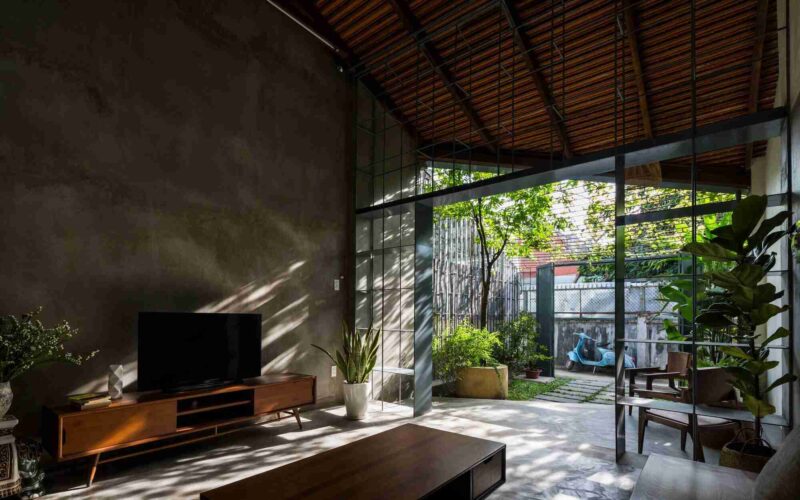Do you ever find yourself craving the fresh air and natural beauty of the outdoors, even when you’re inside your own home? If so, you’re not alone. Many people are eager to merge their interior and exterior spaces, creating a seamless transition that allows the beauty of nature to flow freely throughout their living spaces. This article will explore the concept of merging interior and exterior spaces, discuss the key elements involved, explore design techniques for a seamless transition, and consider practical considerations for successful indoor-outdoor living.
Understanding the Concept of Merging Interior and Exterior Spaces
The Philosophy Behind Indoor-Outdoor Living
Indoor-outdoor living is not simply about bringing some potted plants indoors or opening a few windows. It is a philosophy that embraces connecting with nature and blurs the boundaries between the built environment and the natural world. By incorporating outdoor elements into your interior design, you can create a sense of harmony and tranquility, enhancing your overall well-being.
When you merge interior and exterior spaces, you are essentially creating a seamless transition between the inside of your home and the outside environment. This design approach allows for fluidity of movement and constant interaction with nature. Imagine waking up in the morning and being able to step outside onto a beautifully landscaped patio, surrounded by the sights and sounds of the natural world. This experience can truly elevate your daily routine and provide a deep connection to the world around you.
Benefits of Combining Interior and Exterior Spaces
The benefits of merging interior and exterior spaces are numerous. For one, it allows you to make the most of your available space. By seamlessly extending your living area into the outdoors, you can effectively double the usable square footage of your home. Additionally, incorporating natural elements into your interior design can promote a sense of calm and relaxation, reducing stress and improving overall mental health.
Furthermore, merging interior and exterior spaces can have a positive impact on the environment. By integrating sustainable design practices, such as using energy-efficient materials and maximizing natural light, you can reduce your carbon footprint and create a more eco-friendly living space. This conscious effort to harmonize with nature not only benefits the planet but also enhances the beauty and functionality of your home.
Key Elements in Merging Indoor and Outdoor Spaces
Use of Natural Materials
One key element in merging indoor and outdoor spaces is the use of natural materials. Incorporating materials such as wood, stone, and bamboo can create a sense of continuity between your interior and exterior spaces, visually connecting the two environments. Consider using reclaimed wood for flooring or implementing a stone feature wall to bring the outdoors in. Additionally, modern wall systems can be utilized to enhance this connection, offering structural support while maintaining aesthetic appeal.
Incorporating Plants and Greenery
Plants and greenery are essential in creating a seamless indoor-outdoor transition. Not only do they add visual interest and natural beauty, but they also improve air quality and promote a sense of well-being. Consider adding a living wall or installing an artificial vertical garden to bring the lushness of the outdoors directly into your living space. These features can offer a low-maintenance alternative while still providing the benefits of greenery.
Maximizing Natural Light
Natural light is a crucial element in merging interior and exterior spaces. Strategically placed windows and glass doors can flood your living areas with sunlight, blurring the line between indoors and outdoors. Consider installing floor-to-ceiling windows or opting for glass doors that open up completely to create a seamless transition.
Design Techniques for a Seamless Indoor-Outdoor Transition
Creating Flow with Open Floor Plans
To achieve a seamless indoor-outdoor transition, consider incorporating an open floor plan. Open floor plans eliminate barriers and walls, allowing for an uninterrupted flow between interior and exterior spaces. This creates a sense of unity and makes it easier to move freely between the two areas, enhancing your overall experience.
Using Large Windows and Glass Doors
Large windows and glass doors are essential in creating a seamless indoor-outdoor transition. These elements not only allow for maximum natural light but also provide unobstructed views of the surrounding landscape. Consider using sliding glass doors or floor-to-ceiling windows to frame the outdoors and bring it directly into your living space.
Consistent Design Themes and Color Schemes
To maintain continuity and create a cohesive look, it is crucial to have consistent design themes and color schemes throughout your interior and exterior spaces. This ensures a seamless transition and avoids a disjointed feel. Consider carrying similar materials, colors, and patterns from your outdoor patio to your indoor living area to create a harmonious blend.
Practical Considerations for Indoor-Outdoor Living
Weather and Climate Factors
Before embarking on your indoor-outdoor living journey, it is essential to consider the weather and climate factors specific to your region. Extreme temperatures, excessive humidity, or heavy rain may require additional measures to ensure comfort and safety. Consider installing retractable awnings, outdoor heaters, or natural ventilation systems to adapt to changing weather conditions. Enlisting expert landscaping services can also ensure that your outdoor space is designed to handle local weather challenges effectively.
Privacy and Security Concerns
While merging indoor and outdoor spaces can create a beautiful and harmonious environment, it is essential to balance the need for privacy and security. Consider incorporating privacy screens, fences, or strategically placed landscaping to create secluded areas within your outdoor space. Additionally, ensure that your windows and doors have proper locks and security measures to maintain the safety of your home.
Maintenance and Upkeep
Indoor-outdoor living requires regular maintenance and upkeep to preserve its beauty and functionality. Ensure that you have a plan in place for watering and caring for your indoor plants, as well as maintaining any outdoor landscaping features. Regularly clean and inspect your windows and doors to ensure they remain in good working order, and address any issues promptly to avoid further damage.
In conclusion, merging interior and exterior spaces can create a truly remarkable living environment that seamlessly combines the beauty of nature with the comfort of home. By understanding the concept, incorporating key elements, leveraging design techniques, and considering practical considerations, you can bring the outdoors in and enjoy the benefits of indoor-outdoor living. So why not step into a world where the boundaries between inside and outside fade away, and the serenity of nature fills your living space?


